A hydroelectric dam is one of the major components of a hydroelectric facility. A dam is a large, man-made structure built to contain some body of water. In addition to construction for the purpose of producing hydroelectric power, dams are created to control river flow and regulate flooding. In some rivers, small scale dams known as weirs are built to control and measure water flow. Dams fall into the category of retaining structures, or structures that are built to create large standing bodies of water known as reservoirs. These reservoirs can be used for irrigation, electrical generation, or water supply. Hydroelectricity is one of the fore-runners of the renewable energy industry. Here are 10 Largest hydroelectric Dams in the World in terms of installed power.
1.Three Gorges Dam, China
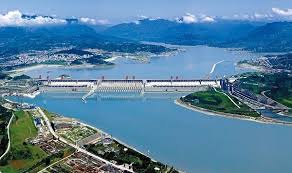
The Three Gorges Dam has been the world’s largest power station in terms of installed capacity (22,500 MW) since 2012. In 2018, the dam generated 101.6 terawatt-hours (TWh). As well as producing electricity, the dam is intended to increase the Yangtze River’s shipping capacity. The dam is located 44km from the city of Yichang in Hubei province. The project has 34 generators, which includes 32 main generators. The other two are power generators with a capacity of 50MW each. When construction of the dam officially began in 1994, it was the largest engineering project in China. At the time of its completion in 2006, it was the largest dam structure in the world. The height of Three Gorges is about 594 feet (181 meters (m)) and the length is about 7,770 feet (2, 335 m).
The dam creates the Three Gorges Reservoir, which has a surface area of about 400 square miles (1,045 square kilometers) and extends upstream from the dam about 370 miles (600 kilometers). The gorge controls approximately one million square kilometres of drainage area and averages a runoff of 451 billion cubic metres annually. Ecology and environmental monitoring information system for the project was opened in 2007. Fish Nurturing Centre Base was also built for the conservation of Asian carp and other species through the eco-scheduling process. The official total cost of the Three Gorges Dam project was estimated as CNY203bn ($29bn).
2.Itaipu Dam, Brazil and Paraguay
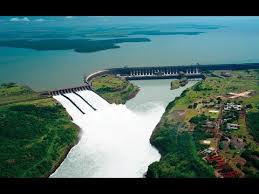
The Itaipu Dam is a hydroelectric dam on the Parana River located on the border between Brazil and Paraguay. The volume of this Dam is 12,300,000 m3 (430,000,000 cu ft) and total capacity is 29 km3 (24,000,000 acre⋅ft). It’s location is Foz do Iguacu, Hernandarias. Itaipu Hydroelectric Dam is the world’s second-largest operational hydroelectric power plant in terms of installed power. With an installed generation capacity of 14GW, the plant is operated by Itaipu Binacional and located on the border between Brazil and Paraguay. Energy generated by Itaipu helps to meet the demands of the two countries. Approximately 90% of the energy generated by the plant is used by Brazil. Itaipu has 20 generating units, each with a capacity of 700MW. The dam’s reservoir, which covers an area of 1,350km² with Spanning of 170 kilometers in length.
The name “Itaipu” was taken from an isle that existed near the construction site. In the Guarani language, Itaipu means “the sounding stone”. To ensure water quantity and quality, Itaipu has created an environmental conservation area, planting more than 44 million trees. The protected areas now total over 100,000 hectares, including reserves and wildlife refuges in both countries and the biological forest corridor that protects the reservoir.Recently, Itaipu became the first hydroelectric plant in the world to have its own protected areas and supporting landscapes which are now recognized by UNESCO as a Biosphere Reserve. Although forest conservation is an essential safety measure for water security, it also depends on other environmental priorities, especially those that relate to land use. It regularly surpasses the production of the larger dam and holds the world record for energy produced, achieving 103.1 terawatt-hours (TWh) in 2016.
3.Xiluodu Dam, China
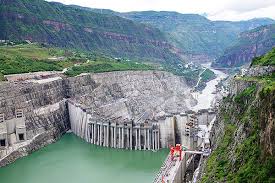
The Xiluodu Dam is an arch dam on the Jinsha River, i.e. the upper course of the Yangtze in China. It is located near the town of Xiluodu in Yongshan County of Yunnan Province but the dam straddles into Leibo County . The primary purpose of the dam is hydroelectric power generation and its power station has an installed capacity of 13,860 MW. The primary purpose of the dam is hydroelectric power generation and its power station has an installed capacity of 13,860 MW. Additionally, the dam provides for flood control, silt control and its regulated water releases are intended to improve navigation downstream. Xiluodu power plant offsets approximately 150m tonnes of carbon dioxide emissions a year. It reduces the consumption of 41 million tonnes of coal for electricity generation. The Xiluodu plant generates 64bkWh of electricity a year.
The Xiluodu plant is made up of two power houses located on both sides of the dam. The power house comprises 18 Francis turbine-generators and an air-cooled generator with 855.6MVA output. The reservoir has a total storage capacity of 16.5 billion cubic yards, of which six billion cubic yards are for flood control. The construction of the dam was carried out using belt conveyors, crawler tractors, hydraulic excavators, rock trucks and wheel loaders. The water discharge structures of Xiluodu Hydropower Station are composed of 7 surface holes of the dam body, 8 deep holes and 4 spillway tunnels on the bank. The main task of flood control operation of Xiluodu Hydropower Station is to control the flood of the Chuanjiang River section and enhance the flood control standard of cities such as Yibin along the bank, while ensuring the safety of the hydro-complex project.
4.Guri Dam, Venezuela
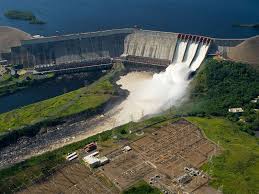
The Guri power project, also known as the Simon Bolivar hydroelectric power station, is located on the Caroni River in the Bolivar State of southeastern Venezuela. Installed Capacity is 10,235 MW. The power plant consists of 20 generating units of different capacities ranging between 130MW and 770MW. Surface Area of this dam is 4,250 km2 (1,641 sq mi). The Guri dam measures 532ft in height and 4,314ft in length. To free a greater proportion of the country’s petroleum for sale and export, the Venezuelan government made the bold move to transition from hydrocarbon- to hydroelectric-generated power as the country’s primary electricity source. The economic efficiency of Guri Dam’s construction can be attributed to its phased development. While other concepts called for the dam to be built to the final height at the first stage a much easier design the region would not have been able to absorb all of the generated power, making it more difficult to finance.
In addition, the compact and incremental design of the dam resulted in inexpensive power at the time approximately US$550 per kW, which attracted aluminum and iron ore smelting industries to the area. Fulfilled government’s goal to significantly decrease dependence on petroleum as a domestic power source: ability to generate more than 10,000MW and produce up to 50,000GWh per year—the equivalent of 300,000 barrels of oil per day. Alstom was awarded two contracts in 2007 and 2009 to refurbish four 400MW units and five 630MW respectively. Andritz received a contract to supply five 770MW Francis turbines for the powerhouse II of Guri in 2007. The Guri power station supplies approximately 12,900GW/h of energy for Venezuela. The plant provides approximately 50,000GW/h of energy to the country annually.
5.Belo Monte Dam, Brazil
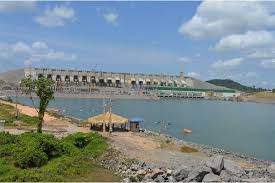
The Belo Monte power station is owned and operated by Norte Energia. The Belo Monte hydropower project under construction on the lower reach of the Xingu River, in Para, Brazil, was installed with 9.39GW generating capacity as of September 2019. The project comprises two dams and two powerhouses, including a main powerhouse equipped with 18 Francis turbines of 611MW capacity each, and a supplemental power house with six 38.85 MW Bulb turbines. The capacity of the dam is 11,233 megawatts (MW). This Dam is the second largest hydroelectric dam in Brazil. Brazil’s rapid economic growth over the last decade has provoked a huge demand for new and stable sources of energy, especially to supply its growing industries. In Brazil, hydroelectric power plants produce over 85% of the electrical energy. The aim is to stimulate the country’s economic growth by building a huge infrastructure of roads and dams, mainly in the Amazon region. The controversial Belo Monte mega-dam in Para state has done significant socio environmental harm to the Xingu River and the indigenous and traditional people living beside it.
Important Brazilian Panel on Climate Change report warned that global warming could drop water levels all across the Amazon basin, putting hydropower in serious jeopardy. Brazil needs Belo Monte and 60 other major dam projects in the Amazon to meet its growing energy demand. Belo Monte’s 668km2 reservoir will flood over 400km2 of forest, generating enormous qualities methane, a greenhouse gas that is 25 times more potent than CO2. Like other big dams, Belo Monte would cause considerable direct and indirect environmental destruction. Belo Monte is only one dam complex, not a series of upstream dams. The government is aware that Belo Monte’s seasonal inefficiency can only be managed by creating more dam reservoirs upstream, allowing technicians to regulate river flows for the entire year. As such, project plans continue to point to the eventual construction of four dams in addition to Belo Monte: Altamira, Iriri, Pombal, and Sao Felix.
6.Tucurui Dam, Brazil
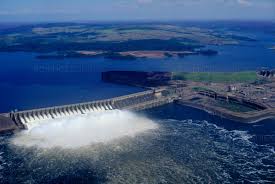
A more modest hydroelectric facility on a small river north of Manaus supplies that city with power. The Tucuruí Hydropower Complex situated on the lower Tocantins River in Tucurui, Para, Brazil. It involved installation of 11 generating units with 370MW capacity each. It is the first large-scale hydroelectric project in the Brazilian Amazon rainforest. The installed capacity of the 25-unit plant is 8,370 megawatts (11,220,000 hp). The power station delivers electricity to the Belem town and the surrounding area. It is located about 350 kilometers from the state’s capital Belém, it caused the flooding of an area of about 3,014 km2 and displaced about 32,000 people. A case study on the social impacts of the Tucuruí dam by Fearnside (1999) reported a systematic overestimation of the plant’s benefits by public authorities, while social and environmental impacts have rather been downplayed, making it an example of Brazil’s unlearned lessons in hydroelectric development.
It notes that most generated power was used for the highly subsidized aluminum industry in Barcarena and Sao Luis. Additionally, dams disturb the flow and composition of the water within rivers and channels. Water released downstream from dams has unnaturally high energy and very little sediment, which causes “hungry water” to run forcefully, eroding the riverbeds, without sufficient sediment concentration to slow it down. This deepens the riverbed compared to the surrounding water table, which causes the ground water to rush into the channel and become surface water – a process known as incision.
7.Grand Coulee Dam, USA
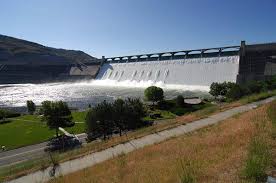
The Grand Coulee hydropower project located on the Columbia River in Washington, US. The annual generating capacity of the plant is more than 24TWh. It consists of total 18 Francis turbines rated 125MW and three 10MW additional units. The Grand Coulee is an ancient river bed in the U.S. state. This area has underlying granite bedrock, formed deep in the Earth’s crust 40 to 60 million years ago. The land periodically uplifted and subsided over millions of years giving rise to some small mountains and, eventually, an inland sea. The dam has four power plants. It is 550 feet (167.6 meters) tall, measured from its foundation in solid granite, or approximately 350 feet (106.7 meters) from the downstream river surface to the top of the dam. It is 5,223 feet (1,592 meters) long, or 57 feet short of a mile. The two original power plants. The total generating capacity is 6,809 megawatts and its average annual energy output is about 2,300 megawatts, or enough power to continuously supply the needs of two cities the size of Seattle.
Hydropower accounts for 79.7 percent of Grand Coulee’s authorized purposes, the others being irrigation and flood control. While hydropower is the primary purpose of the dam today, the public desire for irrigation was the driving force behind its construction. Hydroelectric power plants provide a very efficient, renewable method of generating electricity without producing air pollution. Hydroelectricity produced electricity currently accounts for nearly 7% of the total electricity generated in the United States. However, currently less than 3% of all dams in the United States are used to generate electricity. This discrepancy presents a great opportunity to increase the use of renewable energy production through hydroelectric power. There are many factors which make hydroelectric energy a desirable alternative to the burning of fossil fuels, yet the construction and operation of hydroelectric plants also involves a number of disadvantages. These drawbacks include environmental changes which could adversely affect the health of humans and animals.
8.Xiangjiaba, China
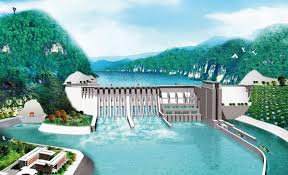
Xiangjiaba is built on the outlet of Jinsha River canyon, which is located Yibin City of Sichuan and Shuifu County, Yunnan, China. The reservoir area is 458,800km² and the reservoir capacity is 5.163 billion cubic metres. The power plant is installed with eight units of 800MW each and comprises various structures for flood discharge, diversion, power generation, and ship lift. The Xiangjiaba is gravity dam with 162m-high and has a crest elevation of 384m. The annual generating capacity of the power plant is 30.88kWh. The Xiangjiaba hydropower facility exploits the lower mainstream water of Jinsha River, a tributary of the Yangtze River. After the successful launch of the Three Gorges hydro power project in 1994, the CTG was authorised for building four hydropower plants namely Xiluodu, Xiangjiaba, Wudongde and Baihetan, all located either on the mainstream or on the tributaries of the Yangtze River. The power output of the Xiangjiaba hydroelectric plant is supplied to central China and east China via the 800kV Xiangjiaba-Shanghai UHVDC (Ultra High Voltage Direct Current) transmission link.
Xiangjiaba will be the third largest hydropower project in the country, after Three Gorges and Xiluodu. As an important part of China’s Great Western Development Programme, the project is expected to drive local social and economic development. It will primarily supply power to China’s central and eastern regions, while at the same time meeting power demand in the Sichuan and Yunnan provinces. The project Xiangjiaba hydro project includes eight turbine generator sets. Major benefits are from power generation to CO2 reduction and flood control. The Xiangjiaba hydropower project brings major flood control benefits, and its combined operation with the Xiluodu hydropower project will improve flood prevention in the downstream coastal cities of Yibin, Luzhou and Chongqing.
9.Sayano-Shushenskaya, Russia
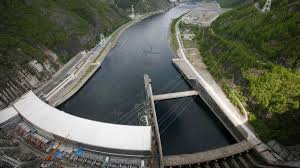
The Sayano-Shushenskaya hydropower plant located on the Yenisei River in Sayanogorsk, Khakassia, Russia. It is operated by RusHydro. An arch-gravity dam 242m tall and 1,066m long was constructed as part of the project. The power plant consists of ten Francis generating units with a capacity of 640MW each. It generates 23.5TWh of energy a year, of which 70% is delivered to four aluminium smelters in Siberia. It is the largest power plant in Russia and the 9th-largest hydroelectric plant in the world, by average power generation. Plant operated ten hydro turbines manufactured at the Leningradsky Metallichesky Zavod, each of which at 194-metre (636 ft) head. The destruction of the turbines and auxiliary equipment at Russia’s Sayano-Shushenskaya Hydro Power Plant in August 2009 claimed the lives of 75 workers and wrecked an indispensable source of electricity that will take years to fully restore.
The disaster, as this report explains, was predictable and preventable. technicians were operating multiple hydroelectric turbines at the plant, including Unit 2, and plant maintenance work on other equipment was continuing. About 70% of the energy generated by RusHydro goes to United Company Rusal’s aluminum smelters, which produce about 12% of the world’s aluminum. It consists of a solid left-bank dam 246.1 metres long, a power dam 331.8 metres long, a spillway dam 189.6 metres long and a solid right-bank dam 298.5 metres long. The dam supports the Sayano-Shushenskoe reservoir, with a total capacity of 31.34 km3, useful capacity of 15.34 km3 and surface area of 621 km2.
10.Longtan Dam, China
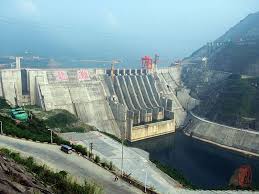
The Longtan hydropower project located on the Hongshui River in Tian’e County, Guangxi, China, is the sixth biggest in Asia. The hydroelectric power station consists of nine Francis 700MW generating units. The Longtan dam is a roller-compacted concrete gravity dam 216.5m in height and 832m in width. The dam is intended for hydroelectric power production, flood control and navigation. The dam contains seven surface spillways, two bottom outlets and an underground power station. This gravity dam more than 700 feet tall, So this is the tallest of its type in the world. The hydroelectric power station consists of 9 power generating units with a capacity of more than 17.3 billion kilowatt hours. This system of valves provides a high quality, reliable solution to the stringent requirements of one of the largest and most advanced hydroelectric generation plants of its kind, ensuring optimal utilization of available natural resources. The project is owned by Longtan Hydropower Development. The dam’s newest hydroelectric turbine was installed in 2009. The design and construction of the dam have applied the state of the art of modern RCC and it also represents the highest level of present RCC construction. After reservoir impoundment, the dam’s operation is normal and presents good performance.
